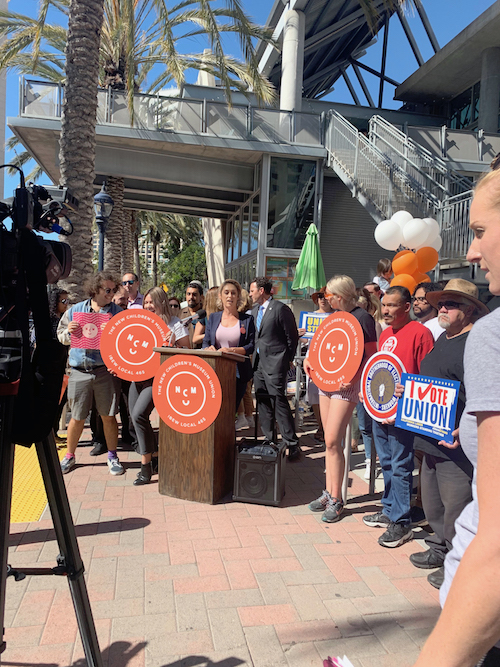In what’s believed to be a first in the IBEW’s history, museum workers have voted in favor of joining the union and have begun to bargain with management over a first contract.
“They’re thinking outside the box and so are we,” said San Diego Local 465 Business Manager Nate Fairman, who hopes this will spur similar organizing drives in his jurisdiction and beyond.
The workers at San Diego’s New Children’s Museum are part of a recent organizing wave among similar nonprofit professional groups, joining student organizations, political campaign staffers and think-tank workers in concluding that union representation and collective bargaining is the best path to job security and better wages and benefits.

|
| During an October press conference held outside the New Children’s Museum in San Diego, Local 465 Organizer Anabel Arauz announced that the museum’s workers had started a campaign to organize with the IBEW in an effort “to highlight the worth of [their] work.”
|
But how did the workers choose the IBEW for representation? “We did get that question,” Local 465 Organizer Anabel Arauz admitted. “They looked at other unions and had some conversations, but their conclusion was that the IBEW is very strong, really great.”
It also helped that there is a personal connection between the museum and the IBEW. “One of the museum workers has a mother who works at San Diego Gas and Electric,” Arauz explained. Local 465 represents workers in several SDG&E units, but none in the utility’s call center, which Hannah Mykel’s mother had tried to organize several years ago.
“I’d heard nothing but good things about the IBEW,” Mykel said, “Well connected, financially stable, progressive, and experts in labor law and bargaining.”
Mykel, who contacted Arauz in March, said that shifting power dynamics at the museum over the last few years had prompted staffers there to begin thinking about organizing. “We’d started to see a really high rate of turnover, and we’d exhausted all of our other opportunities to change things,” she said.
“The museum is not just a place for us to go to make a paycheck,” said Mykel, who has worked there since 2015. “We’re all really devoted to our jobs.”
In an interview with Voice of San Diego, Arauz stressed that not all unionizing efforts stem from workers who are at the end of their rope. “They care a lot about their workplace, and they want to be able to make that workplace a career for themselves, and for future artists and future employees.”
About a quarter-million people visited the museum in 2018, representing a nearly 90% jump in admissions over the past six years. The institution now boasts a reported annual operating budget of $4.8 million from a combination of ticket sale revenue, endowments and charitable donations.
Meanwhile, wages and raises had not been keeping up with the cost of living for most staffers. This is a particular problem in San Diego, which consistently ranks high in surveys of the most expensive metropolitan areas in the U.S. Hourly pay for the museum’s workers, though, was starting only 50 cents above California’s statewide minimum of $12 per hour.
“This trajectory is no longer sustainable without necessary changes that allow staff to grow alongside the museum,” stated ncmunion.org, a website that was the result of a true collaborative effort, created by outside volunteers and maintained by members of the organizing group to help publicize their efforts.
“We are unionizing to highlight the worth of our work and to advocate for higher pay, increased transparency and equitable practices.”
And thanks to the skillful efforts of Fairman, Arauz and others at Local 465, the workers were able to put together a fairly smooth organizing process.
“There wasn’t a ton of pushback from the museum,” Arauz said, something she found a bit surprising considering that the notoriously anti-union Cox Communications, one of the largest cable television and internet providers in Southern California, has a representative on the museum’s board of directors. So does a San Diego labor law firm, which was asked by the museum to set up one-on-one and captive audience meetings with the workers.
“Still, they didn’t spend a whole lot of time or money on an anti-organizing campaign,” she said. “I think that the fact that we were very positive in our messaging helped us. The workers just wanted to have a say.”
After successfully petitioning the National Labor Relations Board to allow for an organizing vote, in-person secret balloting took place in mid-October, and about 70% of the 48 bargaining unit members voted in favor of joining the IBEW and Local 465. “They really want to do this, to take ownership,” Arauz said.
“When we try to change the culture — and here, we are the culture — we have to take responsibility,” Mykel added.
Bargaining unit certification by the NLRB soon followed, and by November the bargaining committee was polling workers about the kinds of things they would like to see proposed in their first contract with the museum. As a starting point, they’re using as a template a contract negotiated by the OPEIU on behalf of workers at the San Francisco Museum of Modern Art.
“We know that other museums are watching how we’re doing,” Fairman said, noting that there are nearly 70 other museums in greater San Diego alone. “We’re finding that this could open some doors for the IBEW.”
At an event in October where the museum’s workers went public about the election and their commitment to vote yes on the question of organizing, Arauz gave out her business card and received some inquiries about possible future organizing efforts from workers at other museums.
“Maybe we can get a few more of them going,” she said.
Workers interested in organizing their workplaces can call the IBEW’s Membership Development Department at 202-833-7000 or visit ibewyes.com to learn more.